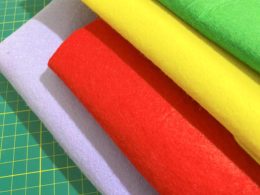Table of Contents
Once you have chosen your felt craft project, you will need to cut the felt. Use smaller sharp scissors (embroidery scissors) with a pointed tip to get a smooth surface and precise edges on your felt shapes. Buy good quality scissors, as the felt dulls them. My advice is to use a pair of scissors only for felting projects to prevent them from getting old and dull.
I recommend using a rotary cutter, a non-slip quilting ruler, and a cutting mat to cut squares, rectangles, or straight lines. It would be best to cut pages for quiet books, puzzle base pieces, felt crown base pieces with a rotary cutter.
A pair of more big scissors are also helpful for cutting out larger, non-detailed pattern pieces.
When cutting felt shapes from a pattern, there are numerous methods for transferring the design to the felt and cutting it out. The most popular is to run your stencil flat side up on freezer paper. The glossy side of the paper will adhere to the felt when ironed, making it easier to cut out the outlines of your shape. You can then peel off the paper.
You can also cut the felt with electronic or manual cutting machines. You can also choose manual cutting machines for felt. You also buy a variety of dies that come in all shapes and sizes with the machine.
You manually slide the felt and die off the machine to cut the felt. Felt is famous for cutting flower shapes. Felt shapes cut on manual cutting machines are limited to available patterns.
How to Cut Felt and Felt Templates
Felt does not wear out once cut and comes in a wide variety of colors. Felt is fun to use for DIY projects, quiet books, finger puppets, and food toys. And without the felt cut, none of these cute felt crafts would exist.
So it’s excellent if you can learn to cut felt numerals, letters, and shapes in various ways. Use tape, freezer paper, needles, fusible interfacing, freehand, and a marker to trim felt. Each method has advantages and disadvantages, so pick the one that best suits your needs.
The materials to be used in felt cutting techniques are as follows:
- The felt template you will use for cutting.
- Felt – a slightly larger piece than your template shape.
- Freezer paper or freezer paper sheets for the freezer paper technique.
- Transparent adhesive tape for taping technique.
- Needles for the needling process.
- Fusible interfacing for fusible interfacing technique.
- Pointed sharp scissors.
- Any scissors for cutting paper.
- A printer if you want to print the template.
- A marking tool on felt. This can be a ballpoint pen, pencil, tailor’s chalk, fabric self-erasing permanent marker, or a water-soluble blue erasable pen.
- Iron for the freezing paper technique and the fusible interfacing technique.
- It is essential to use pointed, sharp scissors to cut the ideal felt shapes.
Felt Cutting with Trace and Cutting Technique
The tracing technique is tracing the form on felt with a pencil, then cutting it out with a fabric marker, pen, or pencil. It’s a quick and straightforward method for cutting felt.
The disadvantage is that it can leave marks on the felt. Also, it may not be as it is challenging to match the pattern exactly. This uncertainty will only matter on parts where the slightest issues of inaccuracy.
The following tips will help you know the marking tools on felt:
- Use a pencil or pen on a light felt.
- If you want to make sure the line is not visible on your finished projects, use the self-erasing marker fabric pen.
- Use tailor’s chalk for a dark felt.
- You can follow the steps below to cut felt with the trace and cut technique:
- On a sheet of paper, print the template.
- Cut the traced template along the lines using a sharp knife.
- With a fabric marker, trace the template to the right of the felt.
- Cut the felt shape just inside the line you traced.
Felt Cutting Using Needle Fixing Technique
The traditional needling technique works perfectly for cutting medium-sized straight-line felt shapes. For this, the needle holds the template in place, making it easy to cut the felt. Also, I recommend this technique if absolute precision is not required.
The advantage of the needle fixation technique is that it is fast, and you do not need any special tools. The downside is that you can lose precision with more complex felt shapes.
To cut felt using the needle fastening technique, you can follow the steps below:
- On a sheet of paper, print the pattern.
- Leave some room around the traced template when cutting.
- Fix the felt shape to the felt’s right side.
- Remove the paper and cut out the felt shape on the marks.
Felt Cutting with Taping Technique
You can apply the taping technique as the next step of the needling approach while cutting felt. It requires clear tape to hold the pattern in place. Cut felt shapes are more exact than needle-punched felt shapes.
The taping technique can be helpful when cutting circles from felt or more intricate designs. However, be careful towards the end of the cut, as the template may slip if not held in place. Gently press the tape to the felt as it sticks easily. If pushed too hard, the felt may flex when tape residue is removed. If desired, test the tape on a piece of felt before you begin.
To cut felt using the taping technique, you can follow these steps:
- On a sheet of paper, print the pattern.
- Leave some space around the traced template.
- Place the tape on the felt’s right side.
- Remove the paper and cut out the felt shape.
Felt Cutting Using the Freezing Paper Technique
The freezer paper technique is the most delicate but also the most laborious. Additional tools required are freezer paper and iron. Freezer paper is a special kind of kitchen paper coated on one side. The freezer paper can be ironed onto felt, making it ideal for cutting delicate felt shapes.
When using freezer paper for sewing or crafting, as long as enough wax remains on it, you may generally reuse it. If possible, try purchasing a quilted freezer paper or A4 cut Freezer Paper, as you can print the template directly onto the paper with your printer.
You may prefer to use an old shirt piece when ironing the freezer paper. If you iron the freezer paper with the shiny side up, you will see that it sticks to the iron.
To cut felt using the freezer paper technique, you can follow these steps:
- Using a pencil, draw the template flat side up on freezer paper or print it using the freezer sheet of the quilting machine. You need to print on the bland side, not the glossy side.
- Leave some space around the traced template.
- Iron the freezer paper to the felt’s right side. Remember that the glossy part must face the felt; otherwise, your iron may be damaged!
- Remove the freezer paper and cut out the felt shape.
Felt Cutting with Fusible Interface Technique
It is a technique that produces precise results but requires a fusible interface and ironing. Note that the interface remains cut felt; therefore, it should be on the reverse side of the felt. It can be advantageous if your shape still requires interfacing to give it more strength to last longer and not stretch.
For example, you can use this technique if you want the felt shape to be stronger and more rigid. First, test the interfacing on a bit of felt to see if there are any issues.
To cut felt using the fusible interfacing technique, you can follow these steps:
- Trace the pattern on the fusible interface, sticky side up, with a marker.
- Leave some space around the traced design.
- Iron the interface on the reverse side of the felt at medium strength. Attention, the sticky part must face the felt!
- Cut out the felt shape.
Felt Cutting with the Cut as You Go Technique
It can be said to be the fastest felt cutting technique. It requires no tools other than your scissors. Ideal for parts where precision is not critical as the pattern is likely to move as you cut the felt shape. Practice is essential to mastering the technique. If you’re a professional, you can quickly cut a felt shape without using a template.
To cut felt using the cut-as-you-go technique, you can follow these steps:
- On a sheet of paper, print the pattern.
- Leave some space around the traced design.
- Maintain a firm grip on the template on the right side of the felt, shifting your finger as needed.
- Remove the paper and cut out the felt shape.
There is no right or wrong method in techniques for how to cut felt. In fact, each has its advantages and disadvantages. That’s why you should choose what works best for you and your felt craft project.
If I’m looking for precision when cutting a felt shape, I use the freezer paper technique. When I don’t have freezer paper, I prefer the banding approach. If a quick cut is needed, I cut as I go. I use the fusible interface if I want the felt shape to be more firm and not elastic.












